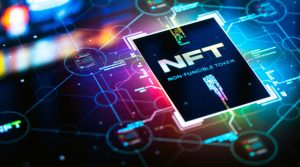As the world becomes increasingly digital, so do our possessions. From digital music and movies to online video games, we’re seeing a shift away from physical items and towards virtual goods. And now, with the rise of non-fungible tokens (NFTs), we’re seeing the creation and sale of unique virtual assets like never before. In this article, we’ll explore what NFTs are, how they work, and why they’re important in the world of virtual goods.
What are NFTs?
NFTs are digital tokens that are used to represent ownership of unique virtual assets. Unlike fungible tokens like Bitcoin, which are all identical and interchangeable, each NFT is one-of-a-kind and can’t be replicated or exchanged for something else. This makes them ideal for representing digital art, music, and other types of creative content that have value but aren’t easily replicated.
How do NFTs work?
NFTs are created on a blockchain, which is a decentralized digital ledger that keeps track of transactions. When an NFT is created, it’s assigned a unique identifier that’s recorded on the blockchain. This identifier acts as proof of ownership, and can be transferred to someone else just like any other type of digital asset.
When someone buys an NFT, they’re buying the ownership rights to the underlying virtual asset. This could be a piece of digital art, a music file, or even a virtual plot of land in a video game. The creator of the NFT retains the original file, but the buyer gets the rights to display, sell, or otherwise use the virtual asset as they see fit.
Why are NFTs important?
NFTs are important because they provide a way for creators to monetize their digital creations in a way that was previously impossible. Before NFTs, digital art and other types of virtual goods had no real value because they could be easily copied and shared. But with the introduction of NFTs, creators can now sell their work as unique, one-of-a-kind assets that have real value.
NFTs also provide a new way for collectors to invest in digital art and other types of virtual assets. Just like with physical art, the value of an NFT can appreciate over time, making it a potentially lucrative investment. And because each NFT is unique, there’s no risk of oversaturation like there is with other types of digital assets.
How are NFTs being used?
NFTs are being used in a variety of ways, from digital art and music to virtual real estate and even in-game items. Some examples of NFTs in use include:
- A digital artwork sold by the artist Beeple for $69 million
- The creation of virtual real estate in games like Decentraland and The Sandbox
- The sale of in-game items like weapons and skins as NFTs
As more and more people become aware of the potential of NFTs, we’re likely to see even more innovative uses of this technology in the years to come.
How do you buy and sell NFTs?
Buying and selling NFTs is relatively easy, but it does require some technical knowledge. Most NFTs are bought and sold on specialized marketplaces like OpenSea and Rarible, which allow users to browse and purchase NFTs using cryptocurrency.
To buy an NFT, you’ll need to create a digital wallet that supports the blockchain on which the NFT was created. You’ll then need to transfer cryptocurrency into your wallet, which you can use to purchase NFTs.
To sell an NFT, you’ll need to create an account on a marketplace and list your NFT for sale.
What are the benefits of NFTs?
NFTs offer several benefits over traditional physical and digital assets. First, they’re completely unique and verifiable, which means that their ownership can be easily proven and transferred. This can be especially useful for high-value assets like artwork, where provenance is critical.
Second, NFTs are highly divisible, which means that they can be broken down into smaller pieces and sold as fractional ownership. This can make it easier for more people to invest in and own a piece of digital art or other virtual asset.
Finally, NFTs are easily tradable on blockchain marketplaces, which means that they can be bought and sold with relative ease. This opens up a new world of possibilities for creators, who can now sell their work to a global audience without the need for intermediaries like galleries or auction houses.
What are the drawbacks of NFTs?
While there are benefits of NFTs, there are also some drawbacks that need to be considered. First and foremost is the environmental impact of blockchain technology. The process of creating and verifying transactions on the blockchain requires a significant amount of computing power, which in turn consumes a lot of energy. This has led to concerns about the carbon footprint of NFTs and other blockchain-based technologies.
Second, NFTs are still a relatively new and untested technology, which means that there are still some risks involved. For example, there have been cases of NFT marketplaces being hacked or compromised, leading to the loss of funds or assets.
Finally, there’s the issue of accessibility. While NFTs offer a new way for creators to monetize their work, they’re still primarily accessible to those with technical knowledge and the ability to invest in cryptocurrency. This means that there’s still a barrier to entry for many artists and creators.
What’s the future of NFTs?
It’s still early days for NFTs, but the future looks promising. As more and more creators begin to realize the potential of this technology, we’re likely to see a wider range of virtual assets being sold as NFTs. We may also see new use cases emerge, such as NFT-based loans or insurance.
At the same time, it’s important to remember that NFTs are just one part of a larger trend towards digital ownership and virtual assets. As our lives become increasingly digital, we’ll likely see a growing demand for unique, verifiable, and tradable digital assets of all kinds.
Conclusion
In conclusion, NFTs represent an exciting new frontier in the world of virtual goods. By providing a way for creators to monetize their digital creations and for collectors to invest in unique, verifiable assets, NFTs are changing the way we think about ownership and value in the digital age. While there are still some challenges and risks to consider, the potential benefits of this technology are hard to ignore. So whether you’re an artist, a collector, or just someone interested in the future of digital ownership, NFTs are definitely worth paying attention to.





